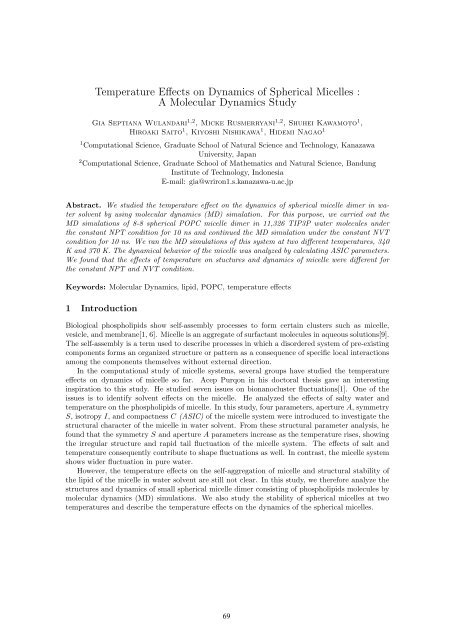RECENT DEVELOPMENT IN COMPUTATIONAL SCIENCE
RECENT DEVELOPMENT IN COMPUTATIONAL SCIENCE
RECENT DEVELOPMENT IN COMPUTATIONAL SCIENCE
Create successful ePaper yourself
Turn your PDF publications into a flip-book with our unique Google optimized e-Paper software.
Temperature Effects on Dynamics of Spherical Micelles :<br />
A Molecular Dynamics Study<br />
Gia Septiana Wulandari 1,2 , Micke Rusmerryani 1,2 , Shuhei Kawamoto 1 ,<br />
Hiroaki Saito 1 , Kiyoshi Nishikawa 1 , Hidemi Nagao 1<br />
1 Computational Science, Graduate School of Natural Science and Technology, Kanazawa<br />
University, Japan<br />
2 Computational Science, Graduate School of Mathematics and Natural Science, Bandung<br />
Institute of Technology, Indonesia<br />
E-mail: gia@wriron1.s.kanazawa-u.ac.jp<br />
Abstract. We studied the temperature effect on the dynamics of spherical micelle dimer in water<br />
solvent by using molecular dynamics (MD) simulation. For this purpose, we carried out the<br />
MD simulations of 8-8 spherical POPC micelle dimer in 11,326 TIP3P water molecules under<br />
the constant NPT condition for 10 ns and continued the MD simulation under the constant NVT<br />
condition for 10 ns. We ran the MD simulations of this system at two different temperatures, 340<br />
K and 370 K. The dynamical behavior of the micelle was analyzed by calculating ASIC parameters.<br />
We found that the effects of temperature on stuctures and dynamics of micelle were different for<br />
the constant NPT and NVT condition.<br />
Keywords: Molecular Dynamics, lipid, POPC, temperature effects<br />
1 Introduction<br />
Biological phospholipids show self-assembly processes to form certain clusters such as micelle,<br />
vesicle, and membrane[1, 6]. Micelle is an aggregate of surfactant molecules in aqueous solutions[9].<br />
The self-assembly is a term used to describe processes in which a disordered system of pre-existing<br />
components forms an organized structure or pattern as a consequence of specific local interactions<br />
among the components themselves without external direction.<br />
In the computational study of micelle systems, several groups have studied the temperature<br />
effects on dynamics of micelle so far. Acep Purqon in his doctoral thesis gave an interesting<br />
inspiration to this study. He studied seven issues on bionanocluster fluctuations[1]. One of the<br />
issues is to identify solvent effects on the micelle. He analyzed the effects of salty water and<br />
temperature on the phospholipids of micelle. In this study, four parameters, aperture A, symmetry<br />
S, isotropy I, and compactness C (ASIC) of the micelle system were introduced to investigate the<br />
structural character of the micelle in water solvent. From these structural parameter analysis, he<br />
found that the symmetry S and aperture A parameters increase as the temperature rises, showing<br />
the irregular structure and rapid tail fluctuation of the micelle system. The effects of salt and<br />
temperature consequently contribute to shape fluctuations as well. In contrast, the micelle system<br />
shows wider fluctuation in pure water.<br />
However, the temperature effects on the self-aggregation of micelle and structural stability of<br />
the lipid of the micelle in water solvent are still not clear. In this study, we therefore analyze the<br />
structures and dynamics of small spherical micelle dimer consisting of phospholipids molecules by<br />
molecular dynamics (MD) simulations. We also study the stability of spherical micelles at two<br />
temperatures and describe the temperature effects on the dynamics of the spherical micelles.<br />
69


